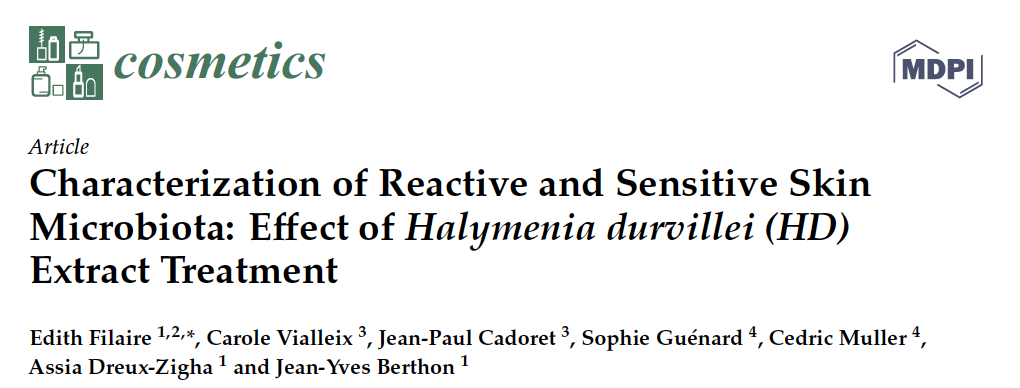Cosmetics : Characterization of Reactive and Sensitive Skin Microbiota: Effect of Halymenia durvillei Extract Treatment
Abstract
After characterization of the reactive skin microbiota, we investigated whether the active Halymenia durvillei (HD), rich in polysaccharides, could modulate this microbiota after 28 days of treatment, act on neuroinflammation parameters, and calm feelings of discomfort and redness. Skin microbiota was assessed using next-generation sequencing experiments (16S RNA gene fragment sequencing) on samples collected from 30 volunteers suffering from reactive, sensitive skin. To evaluate the effect of the HD extract on neuroinflammation, we used an ex vivo model. Finally, an in vivo study was performed using a clinical assessment (blood microcirculation via videocapillaroscopy) of functional signs employing the Sensitive Scale and the soothing effect was evaluated and compared to a placebo treatment. At the phylum level, the samples were mostly composed of Actinobacteria, Proteobacteria, Firmicutes, and Bacteroidetes, which accounted for more than 97% of the total sequencing read in all samples, with no differences before or after treatment with the HD active ingredient. The Shannon Diversity index indicated lower microbial communities compared to healthy skin. Maintenance of the Shannon Diversity index was reported after 28 days of HD active ingredient treatment, wherein microbial communities continued to decrease in number during treatment with the placebo. The average taxonomic composition of associated skin microbial communities showed that reactive skin is characterized by a low proportion of the Chryseobacterium genus compared to a high proportion of the Corynebacterium genus. At the species level, Actinobacteria are mainly represented by Propionibacterium acnes (72.13%) and Corynebacterium kroppenstedtii(13.23%), representing species typically observed in clinical cases of redness, the main criteria for volunteer inclusion. Corynebacterium kroppenstedtii, with increased levels being associated with skin redness, decreased with HD treatment. This decrease coincided with the clinical improvement observed after 7 weeks of treatment. The ex vivo study revealed that the HDextract induced a significant decrease in the expression of TRPV-1 (−67%; p < 0.001) and NK1-R (−43%; p < 0.01) compared to the control after 6 days of treatment. These data support the use of polysaccharides, found in red alga, in the treatment of reactive and sensitive skin related to the modulation of skin microbiota.





